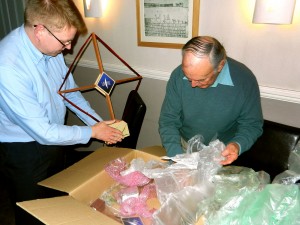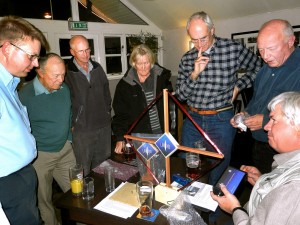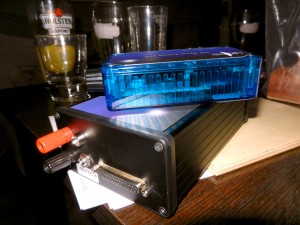October 10, 2012
Radio Astronomy Group Meeting – 10 October 2012
Report by: Grey Lipley
I would like to thank all those who made it to the Ashburmham Arms last Wednesday the 10th October. I hope you had an enjoyable evening, we certainly achieved a lot in such a short time. For those of you who were unable to attend, here is a brief account.
Mike Meynell arrived shortly after me at around 6.45 pm and it wasn’t long before other members of the group joined us in the private side room next to the saloon bar. Once refreshments had been organised we gathered chairs around a single table and the meeting got underway.
To set the ball rolling I gave an update on sourcing radio receiver equipment to work alongside the dish supplied by the ROG.
Conversation moved away from equipment for a while to discuss the role of the Flamsteed Radio Astronomy Group including our desires and aspirations. Mike M wisely reminded us that we need to manage expectations and work toward achievable goals. As a result the following was agreed although not necessarily in this order. The aim of the Radio Astronomy Group is to:
- A. Learn about the subject ourselves
- B. To pass on what we discover to the rest of the Flamsteed Members in the form of occasional talks and updates and
- C. Present the more easily understood aspects of the subject to ROG Visitors by visual means. (This initially by demonstrating equipment and providing graphic material alongside present Solar Viewing sessions).
We had discussed attempting a public demonstration on Saturday 27th October but with only a short time remaining, it was sensibly decided to postpone this until we are more certain of our abilities and that of the equipment.
Mike Meynell then produced a large box containing the newly purchased VLF equipment to be used for Solar Flare Monitoring. This is an indirect method of recording activity on the Sun by studying the effect solar radiation has on our upper atmosphere. As Solar Flares can be infrequent, permanent monitoring and a method of recording is required in order to archive ‘the best bits’. Consequently I will ask the ROG whether we can site the small “crucifix-like” aerial somewhere on site with a feed to a suitable recording device.
In contrast HF / VHF Source Detection and UHF / Micro Wave Detection involves pointing a receiver, hopefully our dish, directly at the Sun or other source of radiation. This method of observation is more suitable for ‘live’ demonstration and could, as a result, supplement Solar Viewing as mentioned earlier. Unlike visual observation, however, the results obtained using radio astronomy cannot be seen and can, as a result, seem abstract to the uninitiated. It was agreed that careful thought had to be given to how findings would be presented to visitors and that use of a laptop was essential to this process. I reminded everyone that free software had been discussed and Adrian Challinor has since identified this as a product called ‘SpectraVue’ which may be suitable for both forms of observation.
See: http://www.rfspace.com/RFSPACE/SpectraVue.html
and: http://www.moetronix.com/spectravue.htm
Keen not to be the one to take home Mike’s package and as a result of all detailed discussion, it was agreed that Clive Inglis would set to work by connecting together all of the items now spread across the table littered with half empty glasses. Similarly it was agreed that Adrian would start to investigate, gather and connect items needed for direct observation using our dish. In this way it is hoped we will soon begin practical, albeit fairly simple, Radio Astronomy and gain confidence within two well defined starter projects.
Pictures from the evening (by Grey Lipley):
Posted under: Flamsteed, Meeting Report, Radio Astronomy







You must be logged in to post a comment.